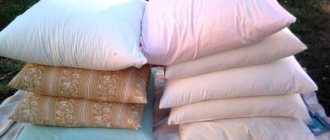When we are born, we begin to acquire documents and, although today many issues are resolved using the Internet, paper documentation still remains an important part of life. Sooner or later, everyone thinks about how to organize order in the house; storage ideas that allow you not to lose a single important paper will be of interest to everyone. The article talks about practical ways to organize and store documents, which, once you get acquainted with them, will help you bring order to your own paper deposits.
How to do it right Source dekormyhome.ru
Storing documents related to everyday life
Keep the documents of each family member, including pets, if you have any, separately.
We put all the documents into files and insert them into a folder with rings. You can glue a piece of paper onto the folder with the name of the person to whom it belongs written. First, files with small documents should go: passports, work books and pension certificates. Next come health-related documents. These are various insurance policies, medical cards, and so on. Then documents about the apartment.
If we talk about a place to store folders, then the best place is a closet or chest of drawers. There are also special boxes and drawers for storing documents. It can be installed on the table where you work. You will be able to take out documents while working as needed, which is very convenient.
Article on the topic: Sliding interior doors - trend or anti-trend 2022?
The best posts
- Scalloped edge pattern for knitting socks with photos and videos
- DIY decor of plastic flower pots
- DIY gifts for a friend’s or mother’s birthday
- Rules for sealing an electric meter
- DIY satin ribbon painting with photos and videos
- Aquilegia from beads: master class with step-by-step instructions
- DIY bead bracelets: master class with photos and videos
- Knitting a women's hat: knitting pattern and description
Methods for storing documents
Needless to say, papers must be kept in order. Otherwise, searching for this or that document will take up a lot of a person’s precious time. Many of us monthly sort through piles of the same type of sheets, trying to find a fresh receipt among bills that have already been paid for a long time. A detailed approach to the distribution of papers helps to cope with this problem. As an example, we will give the most successful ideas and methods for storing documents.
In folders
The optimal solution would be to purchase a product with rings that can hold an impressive number of files with papers (photo). Most of these folders are in A4 format, which is ideal for storing certificates, contracts, real estate documents, etc. If you wish, you should acquire several thin office supplies designed for each field of activity. By sticking notes on folders with the inscriptions “work”, “family”, “housing”, “bank”, you can greatly facilitate the task of finding the required paper. It would also be useful to include in the first file a complete list of documents indicating the pages where they are located. It is recommended to paste receipts and checks onto sheets of A4 format before placing them in a folder. Only the upper left corner should be fixed in order to avoid damage to the documents.
A worthy alternative to a bulky folder is a special briefcase with many compartments, which can be purchased at any office supply store. Such devices are presented in a wide variety of designs, from strict classic ones to elegant feminine ones. Choosing an option to your liking will not be difficult. The only disadvantage of a briefcase folder lies in the impossibility of turning pages and freely viewing documents. Therefore, to ensure his own convenience, the owner of the “securities vault” will have to take care of the appropriate inscriptions and notes. A visual example of placing documents inside a briefcase folder is presented in the video:
In photo albums
As surprising as it may be, such accessories with magnetic sheets can perform other functions besides storing memorable photographs. For example, you can place payment receipts in them, which you don’t have to use glue to secure. In addition, each sheet has space for inscriptions and notes, which is also very convenient.
In envelopes
Paper “pockets” are optimal for storing old receipts, checks and other papers that are time to be archived. Such documents are extremely rarely useful, but many still do not risk throwing them away. By marking the envelope accordingly, you can safely place it in the far corner of a drawer or shelf.
In boxes
You can store almost anything in them, and documents are no exception. However, haphazardly storing papers inside a cardboard container will lead to problems associated with their subsequent search. Therefore, before placing documents in a box, it would be useful to distribute them into separate folders or multi-folders, depending on their purpose. As for passports, diplomas and other non-standard papers in hard covers, it is better to have a separate thick envelope for them. By the way, today there are very convenient accessories made in the form of a filing cabinet with dividers (photo). Some of them can be locked with a key and used as a safe.
Systematization
The basis for storing papers at home, according to which all documents need to be organized, that is, divided into categories. And here there are 3 approaches.
- Sorting is carried out by area of application. That is, the passport and license are kept in one folder, medical certificates in another, receipts in a third. It's simple and effective, you won't get confused anymore.
- Each family member has their own personal box in which a person can put everything they need. Here, cataloging is usually done for parents, children, and even pets. Again, it simplifies life, but it is worth considering that in this option, mom and dad may accumulate much more certificates and certificates over time than Sharik.
- The papers are classified according to the frequency of their use. They are divided into archival “eternal” (photo, registration certificate for an apartment), basic, the need for which arises periodically (driver’s license, medical card, diploma), and current active ones, which will have to be used in the near future (receipts, checks).
All of the listed methods for storing documents can be subject to individual “revisions” - depending on the specific situation. But even in its basic form, each of them is useful, as it significantly saves time on searching for an urgently needed certificate or prevents the birth certificate from getting lost on the mezzanine.
Whatever method you prefer, you must remember that work and personal papers should be kept separately or somehow divided between each other
In principle, the more sorting options, the better, but within reasonable limits - it is important not to overdo it and rationally use the available space so that there is not only one small statement in a large box
Storage systems: drawer, folder, box or organizer
Organizing the storage of documents at home begins with determining the number of papers remaining after the inspection and their purpose. An entrepreneur who has registered an individual entrepreneur at his address, in addition to his personal archive, will have accumulated a lot of accounting reports and other specific information.
Folders for storing documents at home must be signed and placed in a box for business papers. Markings are made on the spines.
The system for storing documents at home begins with classifying storage media by their type. You will have to buy storage folders for the following types of documents at home:
- studies (diplomas, certificates of completion of courses);
- work (work book, employment contract with the employer, certificates from the employment center, letters of gratitude);
- any documents of title to real estate, bank accounts (rent agreements, donations, purchase and sale agreements, certificate of inheritance);
- family (identity cards, national and foreign passports, SNILS, birth, marriage, divorce certificates).
- loans (agreements with credit institutions, debt repayment receipts, statements);
- purchases (receipts, warranty cards, instructions);
- utility bills (paid bills).
https://youtube.com/watch?v=DrVqK0mPOx0
All that remains is to arrange the folders in boxes and drawers intended for storing documents at home. The choice of device depends on the financial capabilities and imagination of the archive owner. It could be:
- Large box for storing documents. Separators are installed between files installed in it.
- File folder. A large folder with already installed files can replace the box.
- An iron safe or box for storing documents will be useful for an entrepreneur who keeps financial reports and other important papers in his apartment.
- Case. A small suitcase with a key lock is suitable for transporting valuable documents.
There are many options; you can watch the video for good ideas on how to organize document storage.
A fireproof iron box for storing documents and valuables at home, is relevant if it contains:
- papers confirming ownership;
- personal seals;
- large amounts of cash.
Sorting documents
Papers can be divided according to the following criteria:
- To the apartment. Receipts for water, gas, and electricity will be stored there.
- Connection. This section will contain contracts and receipts for telephone, television and the Internet.
- Loans. This includes contracts and checks.
- Social services. If the services of these organizations are used, then documents from them should be placed separately.
- Copies. It is advisable to make 5 copies of documents. Better yet, scan them.
- Personal documents. This includes passports and certificates.
- Medicine. It is necessary to fold papers related to health separately.
- Photos. They must be placed in an envelope.
- Instructions and guarantees. If necessary, you can always find the paper you need;
- Rarely used documents.
Small format documents usually have a hard cover. If they are often used, for example, passports, IDs, then you should store them in a small folder with dividers.
WE CREATE ELECTRONIC CASES
There are no questions with paperwork: it is a collection of documents devoted to one issue. Things can be:
- homogeneous (for example, the case “Orders for core activities”, consisting only of orders);
- composite (for example, a composite file “Documents on the provision of services to contractors”, which includes correspondence, copies of contracts and additional agreements and other documents).
All paper documents of the case are filed in one folder.
Electronic files can also be homogeneous and composite. Electronic documents, like paper ones, are also collected in one folder, albeit electronic (file). For example, the electronic file “Internal Memos” can be a folder of the same name, which contains files of official memos from the first to the last number.
In addition to the file that contains the electronic document itself, the folder may also contain files of electronic signatures, metadata of the electronic document - the set depends on the organization’s software.
The formation of electronic files, just like paper ones, should be handled by their executors in structural divisions. The secretary cannot accurately determine which case this or that highly specialized document relates to, does not know industry standards that determine storage periods, etc. I repeat, all this should be done by the performers. The secretary takes on the methodological and consulting part of the work.
Tax returns and papers
In order to easily track the storage periods of certain documents, including declarations, you can find a table with the necessary data on the Internet. It will help every accountant not to get confused and miss deadlines. Otherwise, tax liability may arise with the imposition of large fines. In addition, the Tax Code of the Russian Federation regulates that tax returns can be submitted in electronic format.
How to file documents, watch the video:
The procedure for storing documents in an organization has its own characteristics and deadlines, so every authorized employee or founder of an enterprise should know all the nuances and principles of constructing work. In the article, everyone was able to see not only the regulatory regulation of the issue, but also the features of storage, deadlines in individual cases, the procedure for liquidating an organization and much more. We should not forget that the legislator has formed general principles, but the organizations themselves set their own requirements at the local level.
Write your question in the form below
Storing documents at home: putting your papers in order
In our age of Internet records and technology, the question “where did that little blue piece of paper go?!”, it would seem, should no longer worry anyone in principle. However, it is not. Now, various pieces of paper most often have the status of a wonderful memory that you really want to preserve forever. These could be crusts from tickets to distant countries, an invitation to the theater, or just a sweet note that someone once left for you on the table. Over time, the number of such paper “deposits” grows and grows, imperceptibly turning the room into a warehouse. And what can we say about people who like to write messages on stickers, hanging them here and there...
We found eight ideas for storing papers that will allow you not to lose a single important document and at the same time organize your space in the room.
One collector's experience
A German collector and expert in the field of preserving historically significant documents shares his experience:
I have a couple of old newspapers that have historical value, some of which are over 250 years old. I keep them horizontally between the pages of a large album.
It is important not to put them at the very bottom, where they can be pressed down heavily. From time to time I check to see if the newspapers have shown any signs of aging.
Until now, no traces of time have been seen on them. I flip through the newspapers, checking to see if the pages are still light and looking to see if the pages are stuck together. It is important to protect newspapers from moisture and watch for the appearance of a faded smell. I have not yet encountered any precedent, so I can conclude that my method of storing antique papers works.
Non-trivial ways to store documents
Does the description seem boring? No problem! There are more interesting, convenient ways to store papers.
Organizer board. There are many options for such a device. In its simplest form, it is a panel to which papers are attached with buttons. In more complex versions, the board may have small drawers and hanging mounts.
Mini dresser. It is exactly the same as a regular chest of drawers, but much smaller. It is very convenient to store documents in it. Being sorted into different compartments, they will never get lost! The drawers in the chest of drawers can have different sizes: small ones for small pieces of paper, large ones for drawings.
Hanging box. Just a small box or basket attached to the wall like a mailbox. In such a thing, placed in the hallway, it is convenient to store brought letters and receipts.
Envelope pocket. Similar to the previous option, but it is not a box, but an envelope. You can attach it to a table, refrigerator, closet. Allows you to store temporarily necessary documents without taking up valuable space.
We recommend: How to properly store semolina so that it does not spoil and become prey for bugs?
Waste basket. No, not trash - special, for storage. Placed on a table or in a closet, it can have several compartments. A simple, inexpensive, yet effective way to store documents.
Frequently used papers can be kept in a briefcase folder. It has a carrying handle. It is designed so that the documents in it do not get wrinkled. Typically designed for A4 paper. If necessary, in order not to waste time looking for the necessary crusts, you can simply grab a briefcase folder and run about business.
Recommendations for selection
Before purchasing this or that device for storing important papers, it is useful to consider several points:
- Product material. Cardboard, metal, plastic or iron - the type of storage is appropriate to select for the specific interior of the room.
- Frequency of document movement. If papers stored in a box or organizer need to be taken out often, it is better to purchase a lightweight product. An organizer stand, a file folder or a small archival box made of plastic or cardboard will do. Large archival boxes or metal safes are suitable for storing archives and other documentation that does not require frequent viewing.
- Volume of stored documents. To store current correspondence and papers that are subsequently subject to destruction, it is enough to acquire a multi-level tray. The organizer stand and file folder are convenient for storing documents, but these devices will only hold a certain number of them. Archival boxes and iron boxes with several shelves are suitable for storing a large volume of papers.
- Confidentiality. Securities that can only be seen by their owner or the head of the company are best stored in a safe or case with a lock. For documents that are freely accessible, all other types of storage are suitable.
How to store documents at home?
All people have documents: birth certificate, diploma, certificates, payment receipts, policies, contracts, and we will tell you how to store all this correctly in our article.
First of all, we sort by all family members; documents of mom, dad, and children need to be stored separately. If there are animals in the house, then we also make a separate folder for them.
Sort documents by all family members
We purchase folders of different colors, sizes, textures and transparent files of different sizes from the office supply store. There are portfolio folders that may be suitable for accountants. Some people keep documents, such as pay stubs, in a photo album.
Take a size A 4 folder with rings and insert transparent files. We print or write the name “Anya’s documents”, “Dim’s documents”. To separate documents from each other, it is better to make pictures. We find pictures on the Internet or cut them out of a magazine. For example, in a magazine we find a picture of a girl with documents, an office, insert the picture into a transparent file, and behind it we insert documents that relate to the work: resume, contract that was concluded at work with the employer, salary statement, Taxpayer Identification Number and other workers documentation.
Buy stationery folders in different colors
First, we insert small files and insert small documents there: international passport, work book, pension certificate.
Next, we find another picture and insert the documents that the person needs.
The diploma or certificate is small in size and has a dense base. You can insert it into a folder with documents, or you can fold it separately into a small box or a thick transparent box.
Store small documents in a small box
We take another folder and insert all the documents that relate to health there, we call it “health”. In the folder called “apartment” we insert all the documents that relate to the apartment: receipts for payment for the apartment, intercom, purchase of furniture. If a suspended ceiling was installed in the apartment, or the balcony was glazed, then all contracts must be kept, because there are contacts and guarantees.
If you are going to enter into an inheritance, it is better to buy a folder with small files and store everything related to inheritance matters in it.
Where to store?
The best place to store documents is a closet, cabinet or TV stand. On sale there is a desktop box for documents with certain parameters for the height, width and depth of the cell. This box can be placed on a desktop or on a shelf.
Convenient box for storing documents
If a person works at home and needs a lot of space to store documents, then the best solution would be to buy or make a rack with your own hands, and then arrange folders with documents and boxes.
Securities and documents should not be in a visible place, they should be hidden from prying eyes. If there are children in the house, then you need to hide the documents from them. In infancy, children love to taste everything and can tear everything in their hands.
Storing documents in a rack
Valuable documents can be stored in a safe or cabinet, or you can rent a safe deposit box at a bank.
It is recommended to store valuable documents in a safe
Desktop order
And of course the desktop. Depending on the zone in which your workplace is located, you need to choose a table. It can be square, simple rectangular or angular. The main thing is that it has many compartments and shelves. An ideal option would be a table with four drawers and two mini safes. If the volume of the boxes allows for zoning, then go ahead! Divide them into cells for invoices, bills and other necessary pieces of paper. An excellent option would be a double bottom in a drawer. Any top-secret documents and materials can be hidden there, and even the tax authorities will never dig them up.
How to Organize Your Desk at HomeIdeas for Organizing and Organizing Your Home Office
Don’t forget about the different hooks that are sometimes so necessary for bags and packages. If office furniture manufacturers have not provided such a detail, then it is easy to fill them yourself in any place convenient for you.
Ideas for storing things, documents and office supplies at homeWorkplace at home: organizing order and storageIdeas for storing things in the workplace at home photo
How to store receipts, papers and documents: 3 steps to order
Do you keep losing birth certificates or warranty cards at the most inopportune moments? Are papers taking up too much space? Husband and children can never find their documents? Or maybe everything seems to be in order, but for some reason it’s inconvenient? Well, this is not surprising - many people tend to maintain order everywhere, but not in documents. It's so boring and dull!
However, if you know a few principles and tricks, organizing your papers won't be difficult. Moreover, order here can be restored once and almost forever. But what relief will the mere sight of neat folders with all these receipts, invoices, warranty cards and so on bring you?
So, let's begin.
Step 1. Collect ALL papers and documents in one place
Place all the papers and documents you have in the house in one place. Don’t forget about those papers that hang on the refrigerator and even about the instructions and warranties that are in the boxes of equipment. Everything collected must be laid out on the table or floor.
Attention! Let’s immediately make a reservation that our audit should not include postcards, children’s drawings, letters and other sentimental and semi-sentimental papers
Why is it so important to collect all the papers in one place? The fact is that this whole pile will shock you, you will see with your own eyes how much space all these pieces of paper take up, you will feel how much time you spent moving them back and forth, searching for what you need.
Why is it so important to collect all the papers in one place? The fact is that this whole pile will shock you, you will see with your own eyes how much space all these pieces of paper take up, you will feel how much time you spent moving them back and forth, searching for what you need. And now a spoiler: in the near future, only 3 beautiful daddies (or trays) will remain from this mountain, approximately as in the photo
And now a spoiler: in the near future, only 3 beautiful daddies (or trays) will remain from this mountain, approximately as in the photo.
Now that the whole bunch has been collected, there is nowhere to retreat. Let's take it one step further and get rid of everything unnecessary. From everything in the literal sense of the word. You only need to leave those papers and documents that fall into one of these categories:
- Currently relevant and requiring attention (invoices to be paid, forms to fill out, etc.);
- Necessary for a limited period of time (current year tax documents, warranties, utility bills, etc.);
- Things you need to keep forever (passports, contracts, mortgage documents, birth certificates, etc.).
Attention! At this stage, there is NO need to sort papers into topics like “household documentation”, “car documentation”, etc. This organizing principle will only increase the number of folders and make the system inconvenient
Obviously, you should say goodbye to advertising brochures, expired warranty cards, instructions from equipment that you no longer have, and other rubbish without hesitation. Please also dispose of the following papers:
- Utility bills – they must be kept for 3 years. Anything that lasts longer can be safely thrown away;
- Operating instructions for all available equipment (if necessary, they can be easily found on the Internet);
- Notes and study materials (strictly speaking, if you have not learned the knowledge gained and have not applied it in practice so far, then most likely you do not need them. By the way, if you give yourself the instruction to throw away notebooks immediately after the courses, then the knowledge will be absorbed much better. However, records that really need to be preserved can be photographed or digitized and then stored in a virtual storage. But still try to be as critical as possible when revising this category of papers);
- Business cards;
- Magazine clippings.
Step 3. Organize storage
Place all 3 groups of documents and papers remaining after the audit into three folders
Important: Make sure that the “Documents Requiring Attention” folder is always as empty as possible. If it is full, it means that your business is not very productive.
- It is best to use plastic file folders or regular folders;
- The worst idea for storing papers is accordion folders;
- Folders should be signed so that your household always understands where everything is;
- There is no need to bother with maintaining warranties for electrical appliances. Just stack them and put them in a folder. They are used so rarely that, if necessary, you can spend 1-2 minutes searching for the required coupon.
Place all three folders in one place vertically. For example, you can put them in a magazine rack like in the photo below.
Support the project - share the material with your friends on social networks:
Storage
A fairly pressing question when it comes to the first stage of storage is where to do this and where to put documents so that there are no violations? As a rule, racks and shelves are used for this, which are not exposed to dirt, sunlight and other external sources of danger to paper.
In some cases, it is allowed to store cases in the desktop of the employee who deals with them, that is, the performer. He will bear the same responsibility as the head of the unit for the safety
When it comes to documents of high importance, you need to install a safe or metal cabinet that prevents entry by third parties
The law provides for requirements for the arrangement of archives; there must be not only shelving, but also fireproof cabinets that protect paper from burning and exposure to high temperatures.
Basic mistakes
In such a simple matter, many make typical mistakes, which can then seriously interfere with the search:
- There are many household members involved in work. When one person is busy with something, he knows exactly what is and where it is, and can intuitively understand the harmonious system he has created. Therefore, it is better not to have everyone sorting and classifying, but to choose someone responsible and delegate all the powers to them.
- Little time to organize. It is important to plan the process correctly in order to do everything thoughtfully and methodically, without rushing.
- Incorrect compilation of subsections, discrepancy between deadlines and dates. Subsequently, it is difficult to find what you need. Methodical, regular neglect of these factors leads to disorder.
Often in the process, many people become confused about some papers that are unclear where to put them. They just hide them and then can't remember where. For this type of storage media, it is worth having a separate place that will have to be sorted out regularly.
DVD and Blu-ray discs
One of the most affordable ways to store home archives is also the most unreliable. Yes, you can easily buy several disks and organize your collection, but you won't do anything with the data if the media becomes unreadable. Manufacturers promise us up to 100 years of service life for DVD and Blu-ray discs, but in reality this figure does not exceed 4-5 years. Problems with reading arise due to natural wear and tear, after scratches and abrasions appear on the working surface, and due to non-compliance with the storage temperature conditions.
The main thing that captivates users in this storage method is the volume. For a regular DVD it is 4.7 GB, for a double-sided disc it is 8.5 GB. Blu-ray has the most “pleasant” parameters - you can record photos and videos on them with a total capacity of 25 or 50 GB, depending on the number of working sides (one and two, respectively). True, to record Blu-ray discs you will need not ordinary drives, which are installed in every second laptop and PC, but special ones - expensive and not so popular.
Is it worth using such discs for home archives? Yes, but with several conditions: you will treat them with care, do not leave them in the cold or in direct sunlight, and also make it a rule to copy the data onto new media every 2-3. The old ones can be used as backup for some time.
Popular cloud storages
Let's talk about several popular cloud storage services.
Google Photos
You are allowed to post up to 15 GB of photos and videos for free. If the capacity is exceeded, the data will be compressed. Photos are up to a resolution of no more than 16 megapixels, and videos are no more than 1,080p.
You can use this archive from Windows, Android, iOS, and macOS devices.
After uploading photos to the service, the system groups them depending on the location and time of shooting, using the metadata recorded in the photo. You can easily find the photo you need by entering the item that is depicted in the search. The system will analyze the images and accurately indicate the frames for the request “Car”, “House”, etc.
iCloud
Allows you to place a digital photo archive of up to 5 GB for free.
Works with Apple gadgets.
iCloud allows you to upload photos to albums, reads metadata, and makes it possible to adjust geotags. You can also create Smart Albums. Photos are placed in them automatically after the user has specified the necessary parameters.
Dropbox
Here you can place up to 2 GB of photos for free. You can also increase your free volume by sending links to other users or installing applications.
The Dropbox app works with Windows, macOS, Linux, iOS, Android.
The main advantage is that the application works on any platform.
There is no ability to search for photos by photographed objects, nor is there a function for correcting images. The application is simply convenient for storing photos.
OneDrive
Allows you to place a digital photo archive of up to 5 GB for free.
The OneDrive app is available on Windows, macOS, iOS, Android.
The principle of operation is similar to the Dropbox application. But there are advantages. OneDrive is able to determine the genre of a photo and recognize the objects depicted in it. Photos are also tagged. In the future, you can see where the photo was taken by going to the “Places” tab.
In OneDrive, you can organize your photos by creating albums, folders, and tags.
On Windows 10, OneDrive is installed automatically. When you connect a camera or smartphone to your computer, the system prompts you to save the photo to your media library.
Accounting documents
Primary accounting documents, accounting registers, accounting (financial) statements, audit reports on them are subject to storage by an economic entity for periods established in accordance with the rules for organizing state archival affairs, but not less than five years after the reporting year (Part 1 of Art. 29 of the Federal Law of December 6, 2011 No. 402-FZ “”, hereinafter referred to as Law No. 402-FZ). The storage periods for electronic documents (registers) are established in the same manner as for documentation generated on paper. At the same time, economic entities must store accounting policy documents, standards of an economic entity, other documents related to the organization and maintenance of accounting, including tools that ensure the reproduction of electronic documents, as well as verification of the authenticity of an electronic signature for at least five years after the year in which they were used to prepare accounting (financial) statements last time ().
When determining specific storage periods for individual accounting documents, one should be guided by the List of standard management archival documents generated in the course of the activities of state bodies, local governments and organizations, indicating storage periods, approved by Order of the Ministry of Culture of Russia dated August 25, 2010 No. 558 (hereinafter referred to as the List). This List was developed and approved in pursuance of the provisions of Federal Law No. 125-FZ of October 22, 2004 “On Archival Affairs in the Russian Federation” (hereinafter referred to as Law No. 125-FZ).
In accordance with clause 1.4 of the List, the storage periods for documents are calculated from January 1 of the year following the year of completion of their paperwork.
Please note that most accounting documents and financial statements have a retention period of 5 years. However, some documents have shorter storage periods, while others have longer storage periods. In addition, there are documents that must be permanently stored.
For example:
- accounting (financial) statements (balance sheets, profit and loss statements, reports on the intended use of funds, appendices to them, etc.) are stored (item 351 of the List): a) consolidated annual (consolidated) - permanently; b) annual – constantly; c) quarterly – 5 years (in the absence of annual – permanent); d) monthly – 1 year (in the absence of quarterly – permanently);
- tax returns (calculations) of legal entities for all types of taxes, declarations and calculations of advance payments for insurance contributions for compulsory pension insurance are stored for 5 years (clause 392 of the List);
- declarations and calculations of advance payments for insurance contributions for compulsory pension insurance are stored for 5 years, and in the absence of personal accounts or payroll records - 75 years (clause 395 of the List);
- tax cards for recording income and personal income tax (form No. 1-NDFL), information on the income of individuals is stored for 5 years, and in the absence of personal accounts or payroll records - 75 years (clause 394, clause 396 of the List );
- primary accounting documents and appendices to them, which recorded the fact of a business transaction and were the basis for accounting records (cash documents and books, bank documents, counterfoils of bank check books, orders, time sheets, bank notices and transfer requests, acts of acceptance, delivery, write-off property and materials, receipts, invoices and advance reports, correspondence, etc.), are stored for 5 years, subject to an inspection (audit) (Article 362 of the List);
- correspondence about the purchase of household property, office supplies, railway and air tickets, payment for communication services and other administrative expenses, and the provision of hotel accommodations is stored for 1 year (clause 367 of the List);
- registers of information on the income of individuals are stored for 75 years, as are personal cards and employee accounts (clause 397, clause 413 of the List);
- documents (protocols, acts, calculations, statements, conclusions) on the revaluation of fixed assets, determination of depreciation of fixed assets, assessment of the value of the organization’s property are stored permanently (Article 429 of the List);
- documents (applications, appraisal reports, correspondence, etc.) on the sale of movable property are stored for 10 years (clause 430 of the List);
- acts on the transfer of rights to real estate and transactions with it from the previous to the new copyright holder (from balance sheet to balance sheet) are stored permanently (Article 432 of the List).
Mattress, toilet bowl and jars of buckwheat - these hiding places will be checked first
There are hiding places for money and documents that people use most often. Criminals know about them from the Internet or from personal experience and check first:
- space under the mattress;
- pillows;
- cabinets, shelves with bedding and clothing pockets;
- toilet cistern;
- vases, boxes, pots with house plants;
- drawers of tables and cabinets;
- jars of cereals;
- books;
- space under carpets, paintings, photographs and wall panels;
- oven, including bottom drawer;
- cavities inside household appliances, for example, a rubber band on a refrigerator door, a bag in a vacuum cleaner;
- ventilation holes in the kitchen and bathroom.
It is better not to store anything valuable in these places. But you can use a trick: hide an amount in an obvious hiding place that is not so scary to lose. For example, hide 5,000 rubles behind the toilet, then there is a small chance that the criminal will find what you allowed him to find and will not dig further.
Quartblog Digest
How to store important little things that constantly get lost? – Keys disappearing before leaving the house, an elusive TV remote control and important documents disappearing without a trace in the apartment - we have collected useful ideas on how to deal with all this.
5 Space Organizing Tips – 5 helpful tips to help you keep your home tidy.
Creating a comfortable interior: 30+ most important ergonomic numbers – Ideal parameters of furniture and distances between objects, calculated by scientists. Let's create a comfortable apartment interior together: useful tips and recommendations from Kvartblog.
Fragment of the day: Magic cleaning. The Japanese art of putting things in order at home and in life - We continue to introduce you to interesting and useful books. Today we are publishing an excerpt from “Magic Cleaning. The Japanese art of tidying up your home and life” by Marie Kondo.
Cleaning up your closet: how to store clothes on hangers - 13 tips on how to clean out your closet with clothes and organize effective storage of clothes on hangers.
Photos: koffkindom.ru, pinterest.com, inspiredbycharm.com, julieblanner.com, selfstoragefinders.com
organization, organization of space, order in the house, order
Reducing the total volume of things
The first thing that comes to mind is to reduce the value of the numerator, i.e. get rid of all junk.
We mercilessly throw it in the trash:
- Torn, very worn clothes and shoes that you no longer wear;
- Numerous bags and packaging residues;
- Faulty electronics and household appliances;
- Broken toys (if the child does not need them);
- Free newspapers, pieces of paper with notes.
We sell on the Internet:
- TV (harms mental development, takes up space on the wall);
- Paintings (we will hang shelves instead);
- All unnecessary but useful things.
After the advent of electronic books, cutting down trees to print traditional ones is blatant barbarism.
It is possible that you have accumulated so much trash that you can’t throw it out in a day. Then we get rid of at least one thing every day. The main thing is to do this regularly.
Rules for storing documents at home
To ensure that your documents are always in order, review them regularly to ensure they are up to date. Get outdated quickly:
- Paid utility bills. This information is valid for three years;
- Annually renewable contracts.
It is convenient to make any payments online through your Sberbank personal account. If there are any misunderstandings with the rent, you can always find the required receipt in the history and print it out on paper. Money is also transferred for children’s meals at school, and monthly parental fees for preschool institutions are paid. The convenience is that the electronic form is stored for a long time on the bank’s official website, and does not gather dust in piles at home.
Cleaning secrets
Experienced housewives advise filling the toilet with cleaning agent when leaving for work. Then it will always shine white.
- A roller with adhesive tape will help you deal with hair anywhere.
- With abrasions and scratches on leather furniture - shoe polish.
- With limescale on faucets and shower heads - table vinegar. They also remove scale from teapots and coffee machines.
- Dry baking soda is ideal for removing stains on upholstered furniture.
Dust will settle less on the furniture if you wipe it with fabric softener.
These simple tips will help a woman, without spending a minimum of effort to maintain order in the house, not turn into Cinderella from a fairy tale.
Summarize?
z
Don't wait for your first negative experience with data loss. Think rationally about the idea of backing up your files now. And then just choose the solution that suits you best. Fortunately, today there are devices on the market for every taste: from light and compact external drives with a USB interface and a convenient backup program to serious multi-disk drives that can be used both for storing photographs and for processing. Choose what suits you! And in our turn, in the very near future we will tell you about several of the most successful drive models, conduct tests on them and describe in detail the entire setup process.











